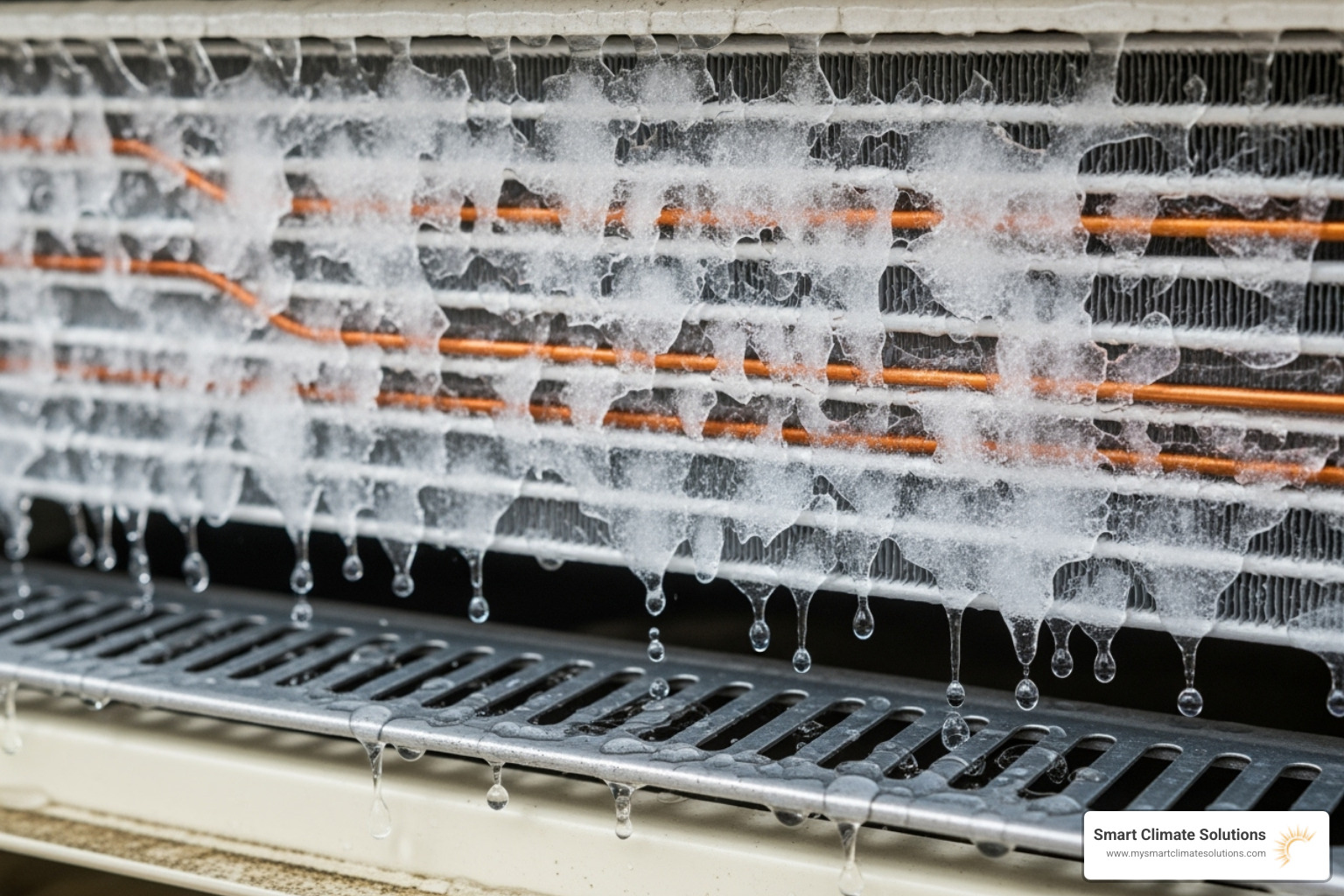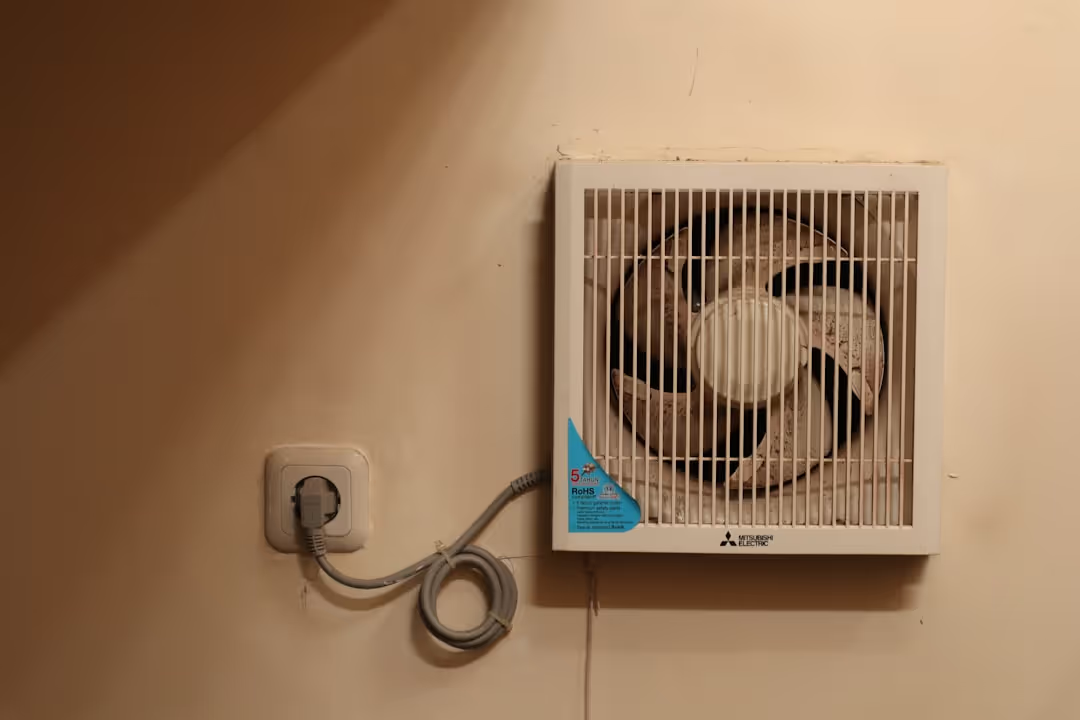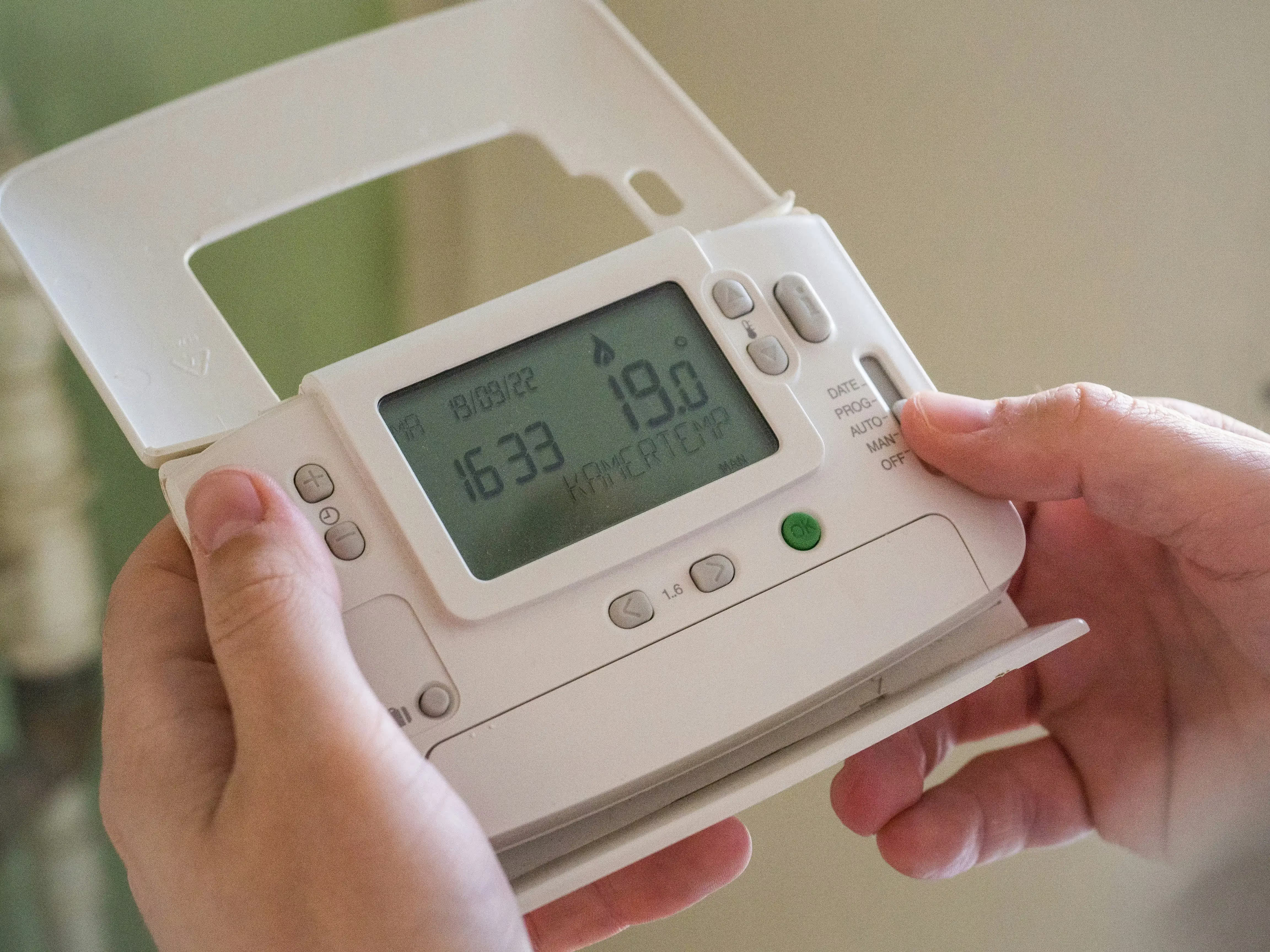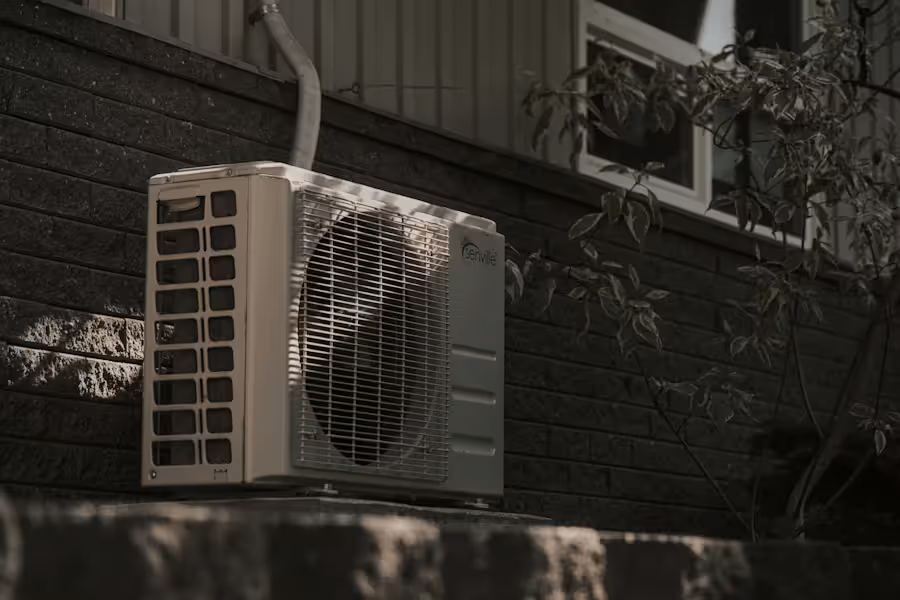When Your Brand New AC Leaves You Hot and Bothered
A new air conditioner not cooling is one of the most frustrating problems a homeowner can face. You've just invested thousands of dollars in a fresh HVAC system, yet your home feels like an oven instead of the cool sanctuary you expected.
Common causes of a new air conditioner not cooling:
- Incorrect thermostat settings - Fan set to "ON" instead of "AUTO" or system in "Heat" mode
- Improper installation - Wrong unit size, faulty refrigerant charge, or leaky ductwork
- Clogged air filter - Restricts airflow even in new systems
- Tripped circuit breaker - Power issues from installation work
- Refrigerant leaks - Can occur during installation or from manufacturing defects
- Frozen evaporator coils - Usually caused by airflow restrictions
- Electrical problems - Faulty capacitors, contactors, or loose wiring
The good news? Many of these issues have simple fixes you can try before calling a technician. Others, like installation errors or electrical faults, require professional attention but are often covered under warranty.
As someone who's been troubleshooting new air conditioner not cooling issues for over 15 years in the Pittsburgh area, I've seen nearly every scenario that can leave homeowners sweating in their own homes. In this guide, I'll walk you through the step-by-step process to diagnose why your new AC isn't performing as expected.

Quick Fixes: Simple Checks to Perform First
Before you panic and call for an emergency service visit, let's walk through some surprisingly simple checks that often solve a new air conditioner not cooling problem. I've seen homeowners spend sleepless nights in sweltering heat, only to find the fix was as easy as flipping a switch or changing a battery.
Start with your thermostat - it's the command center of your cooling system. You'd be amazed how often a new air conditioner not cooling issue comes down to a simple setting mix-up.
First, check if your system is actually in 'Cool' mode. I know it sounds obvious, but we've all accidentally hit the wrong button. Look for the snowflake symbol and make sure your desired temperature is set at least 5-6 degrees below your home's current temperature.
Next, examine your fan setting. If it's set to 'ON' instead of 'AUTO', your system will continuously blow air even when it's not cooling. This creates the frustrating experience of feeling warm air when you expect cool relief. Switch it to 'AUTO' so the fan only runs during actual cooling cycles.
Don't forget to check your thermostat batteries. A blank or flickering display often means dead batteries are preventing your system from getting proper commands.
Power problems are another quick fix that catches many homeowners off guard. Your new AC draws significant electricity, and installation work sometimes trips circuit breakers.
Head to your electrical panel and look for breakers labeled "AC," "Furnace," or "HVAC." If you find one in the middle position or flipped to "OFF," that's your culprit. Reset the breaker by pushing it firmly to "OFF," waiting a few seconds, then switching it back to "ON." Also check the outdoor disconnect switch near your condenser unit - it should be in the 'ON' position.
If the breaker keeps tripping repeatedly, stop trying to reset it. This signals a serious electrical issue that needs professional attention.
Your air filter deserves immediate attention, even in a brand-new system. Construction dust, regular household debris, and even packaging materials can clog filters faster than you'd expect. A blocked filter chokes your system's airflow, making it nearly impossible to cool effectively and potentially causing your evaporator coils to freeze.
Check your filter monthly and replace it every 1-3 months, or more often if you have pets or allergies. A clean filter is one of the simplest ways to ensure your AC runs efficiently.
Finally, take a quick walk around your home to check for blocked vents and registers. Furniture, rugs, or curtains covering supply vents force your system to work much harder without delivering cool air where you need it. Your return air vents (the larger grilles) are equally important - they need clear space to draw warm air back into the system for cooling.
After completing these checks, give your system 15-30 minutes to respond. Sometimes patience is all that's needed for a new air conditioner not cooling to start working perfectly. If you're still not feeling that blessed cool air, it's time to dig deeper into potential installation or mechanical issues.
Why Is Your New Air Conditioner Not Cooling? Installation and System Faults
When your new air conditioner not cooling problem persists after those basic checks, we're usually looking at something more serious. In my two decades of HVAC experience here in Pittsburgh, I've found that installation issues and early system faults are often the real culprits behind a brand-new AC that won't cool your home.
The frustrating truth? Even the highest-quality equipment can fail miserably if it's not installed properly or if there's a manufacturing defect that shows up early.
Improper Installation: A Top Reason a New Air Conditioner is Not Cooling
You'd think a brand-new system would work flawlessly, right? Unfortunately, improper installation is one of the most common reasons I get calls about a new air conditioner not cooling. It's like buying a Ferrari and having someone install bicycle tires on it.
Incorrect unit sizing is probably the biggest installation mistake I see. Your HVAC contractor should have performed a detailed load calculation for your home, but sometimes they take shortcuts or make assumptions that cost you comfort and money.
An undersized AC unit will run constantly, like a hamster on a wheel that never stops. It's desperately trying to reach your set temperature but just doesn't have the capacity to keep up, especially on those sweltering summer days. You'll notice it running all day long, your electric bills will be sky-high, and your home still won't feel comfortable. The constant strain also wears out components much faster than they should.
On the flip side, an oversized AC unit creates a different set of problems. It cools your home too quickly, causing what we call "short-cycling" - the system turns on, rapidly cools the air, then shuts off before it can properly remove humidity. Your home might feel cold but clammy, like a damp basement. Plus, all that starting and stopping wastes energy and puts unnecessary wear on your equipment.
Poor dehumidification from an oversized unit is particularly miserable. You might have the thermostat set to 72 degrees, but the air feels sticky and uncomfortable because the humidity is still high.
The faulty initial refrigerant charge is another installation error that'll leave you sweating. Refrigerant is the lifeblood of your cooling system - it's what actually absorbs heat from your home's air. Your new AC should come with the exact amount needed for optimal performance, but if the installer didn't charge it correctly during setup, your cooling will suffer.
Here's the thing about refrigerant: it doesn't get "used up" like gasoline in your car. If your new system is low on refrigerant, there's definitely a leak somewhere that happened during installation.
Leaky ductwork from installation is another sneaky problem. Sometimes during the installation process, existing ducts get damaged, or new connections aren't properly sealed. All that beautiful cool air your AC is producing escapes into your attic or crawl space instead of reaching your living areas. It's like trying to fill a bucket with holes in it.
If you want to learn more about how we handle installations to avoid these common pitfalls, check out our HVAC Installation services.
Refrigerant Leaks: The Telltale Signs
While refrigerant leaks are less common in brand-new units, they can happen due to manufacturing defects or installation errors. When they do occur, they're serious business that requires immediate professional attention.
Hissing or bubbling noises are often the first clue something's wrong. You might hear these sounds coming from either your indoor or outdoor unit - it's literally the sound of refrigerant escaping from the system.
Oily residue on lines is another telltale sign. Refrigerant contains special oils, so if you notice greasy spots around the copper refrigerant lines or on AC components, that's a red flag.
The most obvious symptom is ineffective cooling over time. Your system runs and runs but never quite reaches the temperature you've set. As more refrigerant leaks out, the cooling performance gets progressively worse.
Environmental and safety concerns make refrigerant leaks something you should never try to fix yourself. These chemicals are potent greenhouse gases and can be harmful to your health if you're exposed to them. Only certified professionals have the proper equipment and training to safely locate leaks, repair them, and recharge the system.
For more information about common AC issues, the Department of Energy has helpful resources: Information on common AC problems. If you're worried about potential repair costs, especially for major components, our guide on AC Compressor Repair Cost can help you understand what to expect.
A Frozen System: What It Means When Your New AC Ices Up
Seeing ice on your new air conditioner not cooling properly is both alarming and surprisingly common. If you notice ice forming on your indoor unit or on the larger copper line running to your outdoor unit, your system is literally freezing up.

Restricted airflow as primary cause is usually what's happening here. Your evaporator coil needs warm air flowing over it constantly to work properly. When that airflow gets blocked or reduced, the refrigerant inside the coil gets too cold, and moisture in the air freezes on contact.
Dirty filters are the number one culprit, even in new systems. Construction dust, pet hair, or just regular household dust can clog a filter faster than you'd expect. Blocked vents create the same problem - if furniture is covering your supply vents or return air grilles, you're choking off the airflow your system desperately needs.
Low refrigerant levels from a leak can also cause freezing, though restricted airflow is much more common in new installations.
What to do: turn AC off immediately if you see ice. Switch your thermostat to "Off" or "Fan Only" mode to help circulate room-temperature air over the frozen coil. Don't try to chip the ice off - you could damage the delicate fins on the coil.
The thawing process takes patience. Depending on how much ice has built up, it could take anywhere from 12 to 24 hours for everything to melt completely. Put some towels around your indoor unit to catch the water as it melts.
Once everything's thawed out, address whatever caused the freezing in the first place. Change that filter, open those vents, and see if the problem returns. If it does, especially if you suspect a refrigerant leak, that's when you need to call in the professionals.
Diagnosing Outdoor Unit and Electrical Problems
When your new air conditioner not cooling mystery persists after checking the basics, it's time to investigate what's happening outside your home. Your outdoor condenser unit works just as hard as the indoor components, and electrical gremlins can sneak into even the newest systems.
Outdoor Condenser Unit Not Working
Think of your outdoor condenser as the hardworking cousin who never gets invited to family dinners. It sits outside in all weather, quietly doing the heavy lifting of releasing heat from your home. When it can't do its job properly, your entire cooling system suffers.
Debris blocking the unit is surprisingly common, even with new installations. Leaves, grass clippings, and that mysterious outdoor fluff seem magnetically attracted to condenser units. Your unit needs to breathe - we recommend keeping at least 18 to 24 inches of clear space on all sides. I've seen units completely choked by overgrown landscaping just weeks after installation.
Dirty condenser coils might seem unlikely in a new system, but construction dust, pollen, and everyday outdoor grime work faster than you'd think. These coils need to release heat efficiently, and even a thin layer of dirt acts like a winter coat on a hot day. You can gently rinse the coils with a garden hose (power off first!), but avoid high pressure that might damage the delicate fins.
Speaking of those fins, damaged coil fins can happen during installation or from normal outdoor hazards like hail or overzealous landscaping. These thin metal strips help maximize heat transfer, and when they're bent or crushed, airflow suffers. While you can carefully straighten minor damage with a fin comb, significant damage needs professional attention.
The most obvious sign of trouble is when your condenser fan isn't spinning. That big fan on top should be turning whenever your AC is running. If you hear humming but see no movement, or if it's completely silent, you've likely found your culprit. This often points to electrical issues we'll discuss next.
Regular maintenance keeps these problems at bay. A professional tune-up can catch issues before they leave you sweating: AC Tune-Up.
Electrical Glitches: Simple Fixes for a New Air Conditioner Not Cooling
Electrical problems in a new air conditioner not cooling situation can be particularly frustrating because you expect everything to work perfectly. Unfortunately, even new installations can have electrical hiccups.
Start with the outdoor disconnect switch - that little electrical box near your condenser unit. Think of it as the outdoor unit's personal on/off switch. Sometimes these get bumped to the off position during landscaping or by curious kids. Make sure the switch inside is firmly in the "ON" position.
Blown fuses can happen even in new systems, especially if there was a power surge during or after installation. Check both your main electrical panel and any fuses in the outdoor disconnect box. A blown fuse usually has a blackened appearance or a broken filament inside.
The faulty capacitor is a sneaky troublemaker that can fail even in brand-new units. This cylindrical component gives your compressor and fan motor the electrical boost they need to start. If your outdoor unit hums but nothing happens, or if the fan struggles to get going, suspect the capacitor. Warning: capacitors store dangerous electrical charges even when power is off, so leave this repair to professionals.
A bad contactor acts like a faulty light switch for your outdoor unit. When it fails, power can't reach the compressor and fan, leaving you with a silent, non-cooling system. You might hear clicking sounds as it tries unsuccessfully to engage.
Loose wiring from installation is more common than you'd hope. Even experienced installers occasionally leave connections less than perfect. Vibration from normal operation can worsen loose connections over time, causing intermittent problems that are maddening to diagnose.
While checking the disconnect switch is safe, most electrical repairs require professional expertise. Electricity and air conditioning components don't forgive mistakes. Our certified technicians handle these potentially dangerous repairs safely and efficiently: 24 Hour AC Repair.
Electrical problems can pose serious safety risks. When in doubt, call the professionals rather than risking injury or further damage to your new system.
Frequently Asked Questions about New AC Problems
When you're dealing with a new air conditioner not cooling, it's natural to have a lot of questions. After helping thousands of Pittsburgh area homeowners through this frustrating situation, here are the most common concerns we hear - and the answers that can help put your mind at ease.
Should I turn my AC off if it's not cooling?
Yes, absolutely - and this is one of the most important decisions you can make when your new air conditioner not cooling properly. I know it seems counterintuitive when you're already hot and uncomfortable, but continuing to run a malfunctioning AC is like driving a car with a flat tire - you're only making things worse.
Turning off your AC prevents further damage to the compressor, which is essentially the heart of your cooling system. When your evaporator coil is frozen or airflow is restricted, your compressor has to work incredibly hard against these obstacles. Think of it like trying to breathe through a straw - eventually, something's going to give out, and compressor replacement can cost thousands of dollars.
It also allows frozen coils to thaw properly. If ice has formed on your indoor coil, running the system will only add more ice. By switching to "Fan Only" mode or turning the system off completely, you give that ice time to melt naturally. This prevents water damage from overflowing condensate pans and gets your system back to normal operation faster.
Plus, you'll save energy and money on utility bills. An AC that's running but not cooling is essentially burning money. Your electric meter keeps spinning while you get zero comfort benefit. Shutting it off stops this waste and gives you time to properly diagnose the issue.
How do I know if my new AC is the wrong size for my home?
Figuring out if your AC is incorrectly sized can be tricky because both undersized and oversized units cause problems - just different ones. After two decades of fixing sizing mistakes, I can tell you the signs are pretty clear once you know what to look for.
Undersized units run constantly without reaching the set temperature. If your AC runs from morning until night, especially during hot weather, but your home never quite feels comfortable, it's likely too small. You'll notice the system rarely if ever shuts off, and on really hot days, the indoor temperature might actually climb even with the AC running full blast. It's like trying to fill a bathtub with a garden hose while the drain is open - you're fighting a losing battle.
Oversized units cool too quickly and fail to remove humidity, leaving the air feeling clammy. This one surprises people because they think bigger is better. But an oversized unit will blast cold air, satisfy the thermostat quickly, and shut off before it has time to pull moisture from the air. Your home might hit the right temperature, but it feels sticky and uncomfortable. You'll also notice the system turning on and off frequently throughout the day - we call this "short-cycling."
The only way to know for sure is through a professional load calculation that considers your home's square footage, insulation levels, window types, and local climate. It's detailed work that requires experience and specialized knowledge - not something that can be eyeballed or guessed at.
Is a problem with a new AC covered by warranty?
Typically yes - and this is one of the silver linings of dealing with a new air conditioner not cooling issue. When you invest in a new system, you're actually protected by two different warranties that work together to cover both parts and labor.
The manufacturer warranty covers parts like your compressor, coils, and fan motors against defects in materials or workmanship. These warranties usually run 5 to 10 years, with some premium manufacturers offering even longer coverage on major components. The compressor, being the most expensive part, often gets extended coverage because manufacturers stand behind their engineering.
Your installer's labor warranty covers workmanship issues that arise from the installation process. This includes problems like improper refrigerant charge, loose electrical connections, or ductwork issues that stem from installation errors. At Smart Climate Solutions, we stand behind our work because we know proper installation is crucial for system performance and longevity.
Here's the key point: it's crucial to use certified installers to ensure warranties are honored. Manufacturers can void their warranty if the system wasn't installed by qualified technicians or if proper procedures weren't followed. That's why choosing an experienced, certified company like ours protects not just your immediate comfort, but your long-term investment as well.
Our certified technicians bring over 15 years of experience to every installation, ensuring our customers throughout Pittsburgh PA, South Hills PA, Burgettstown PA, Washington PA, Steubenville OH, St. Clairsville OH, and Weirton WV get installations that work properly from day one and stay covered under warranty for years to come.
Conclusion: When to Call the Professionals
We completely understand the frustration that comes with a new air conditioner not cooling. After investing thousands of dollars in what should be a reliable cooling system, the last thing you want is to be sweating in your own home. While our step-by-step guide has hopefully helped you identify and potentially resolve some of the simpler issues, knowing when to call in the experts can save you both time and money in the long run.
You're now equipped with the essential DIY checks that every homeowner should know: verifying thermostat settings, ensuring your air filter is clean, checking for tripped breakers, and making sure your outdoor unit is clear of debris. These straightforward steps can often resolve common issues and might save you an unnecessary service call.
However, the reality is that many causes of a new air conditioner not cooling involve more complex problems that go beyond basic troubleshooting. Improper installation issues like incorrect sizing or faulty initial refrigerant charge require professional expertise to diagnose and correct. Refrigerant leaks need specialized equipment to detect, repair, and safely recharge the system. Complex electrical faults involving capacitors, contactors, or intricate wiring problems can be dangerous for untrained individuals to handle.
If your unit keeps freezing up even after you've addressed basic airflow restrictions, or if you notice persistent cooling problems despite checking all the simple fixes, it's time to step back and let the professionals take over.
Attempting to tackle these advanced problems yourself isn't just risky - it can actually cause more damage to your expensive new system. Safety risks from handling refrigerants or high-voltage electrical components are very real. Refrigerants are toxic and can harm your health, while electrical work can result in serious injury or even death if handled improperly.
Your new AC represents a major investment in your home's comfort and value. A professional diagnosis ensures the system operates efficiently and lasts for years to come. Sometimes what seems like a complex problem has a simple solution that an experienced technician can spot immediately.
At Smart Climate Solutions, our certified technicians bring over 15 years of experience to every service call. We've seen virtually every scenario that can cause a new air conditioner not cooling, from installation errors to manufacturing defects. Our team provides fast, reliable service with 24/7 emergency support because we know that comfort can't wait, especially during Pittsburgh's hot summer days.
We proudly serve homeowners throughout Pittsburgh PA, South Hills PA, Burgettstown PA, Washington PA, Steubenville OH, St. Clairsville OH, and Weirton WV. Our goal is simple: ensuring your new air conditioner performs exactly as it should, keeping your home cool and comfortable all season long.
Don't let a new air conditioner not cooling leave you hot under the collar any longer. If you've worked through our troubleshooting steps and your system is still struggling, it's time to call the professionals you can trust.








.png)
